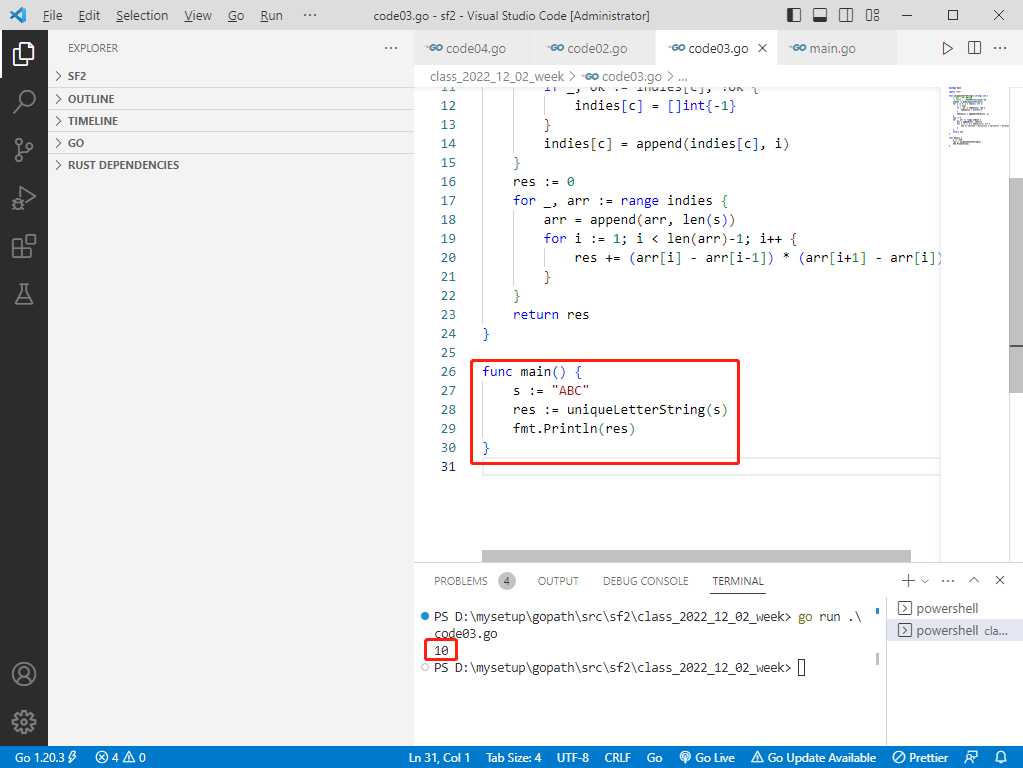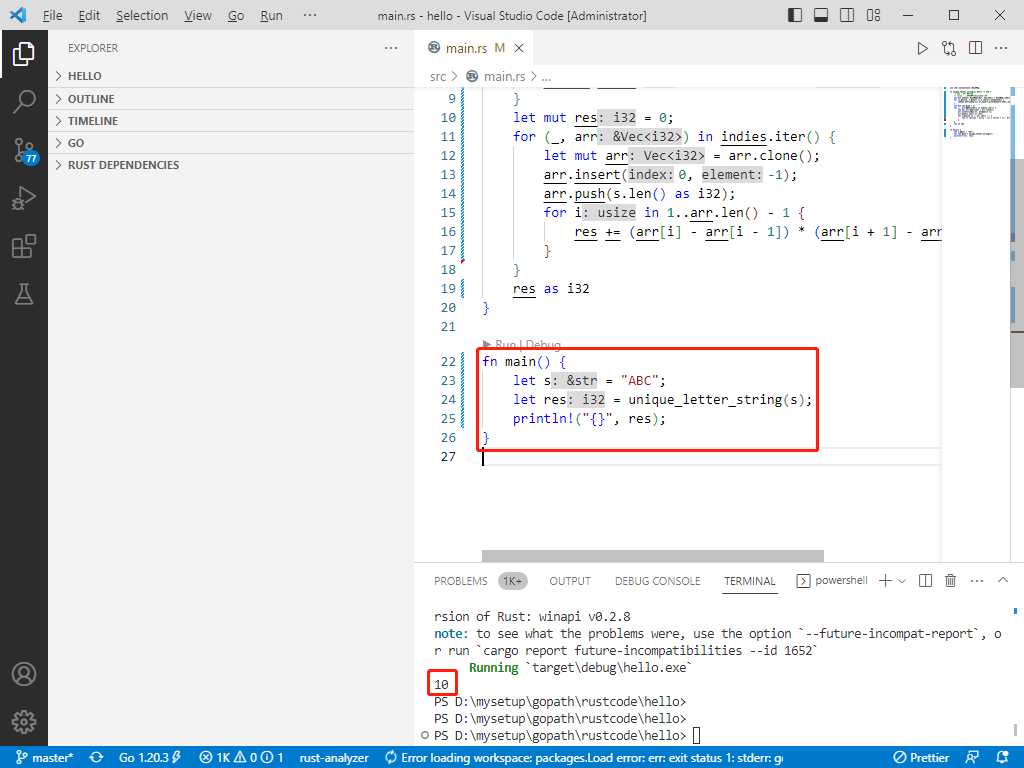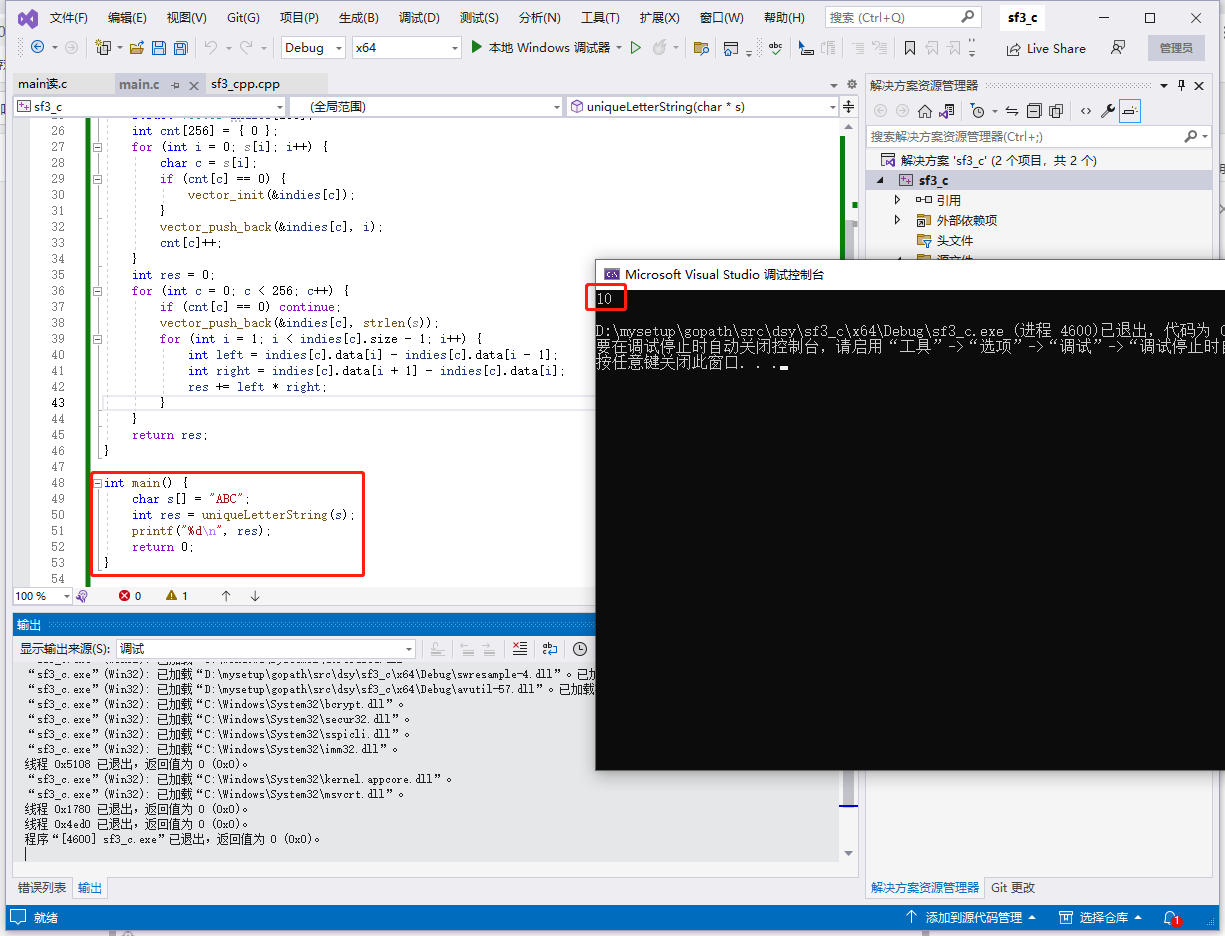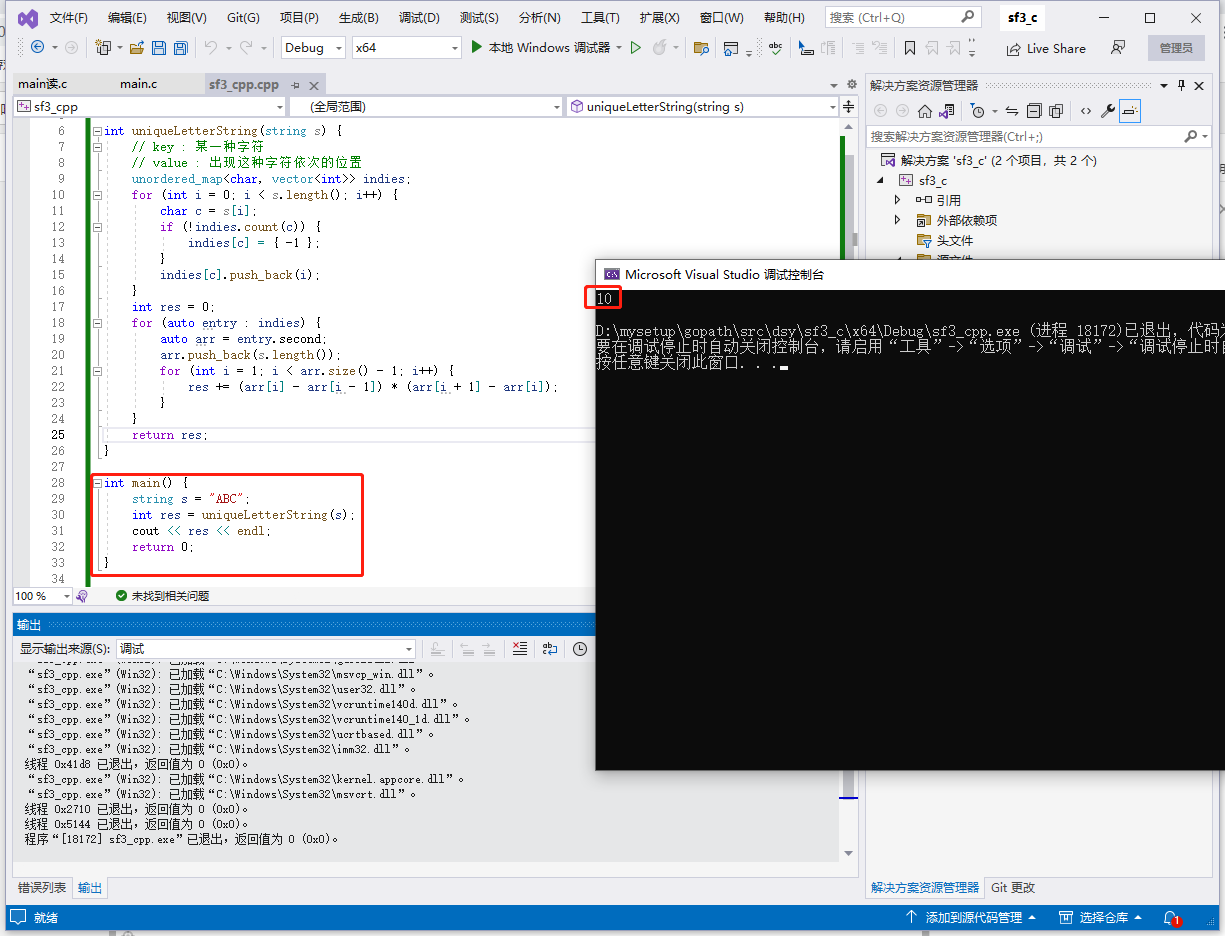2023-05-08:我们定义了一个函数 countUniqueChars(s) 来统计字符串 s 中的唯一字符,
并返回唯一字符的个数。
例如:s = "LEETCODE" ,则其中 "L", "T","C","O","D" 都是唯一字符,
因为它们只出现一次,所以 countUniqueChars(s) = 5 。
本题将会给你一个字符串 s ,我们需要返回 countUniqueChars(t) 的总和,
其中 t 是 s 的子字符串。输入用例保证返回值为 32 位整数。
注意,某些子字符串可能是重复的,但你统计时也必须算上这些重复的子字符串
(也就是说,你必须统计 s 的所有子字符串中的唯一字符)。
输入: s = "ABC"。
输出: 10。
答案 2023-05-08:
1.定义函数 countUniqueChars(s),参数为字符串 s,返回值为整数。
2.创建一个空的哈希表 indies 来记录每个字符出现的位置。
3.遍历字符串 s 中的每个字符,对于每个字符:
3.1.检查该字符是否已经在 indies 中出现过,如果没有则将其加入哈希表,并将初始位置 -1 添加到其位置数组中。
3.2.将当前字符的位置添加到其位置数组中。
4.初始化计数器 res 为 0。
5.遍历哈希表 indies 中的每个键值对,对于每个键值对:
5.1.在该键所对应的位置数组的末尾添加字符串 s 的长度,方便后续计算。
5.2.遍历该键所对应的位置数组中除了开头和结尾的位置,对于每组相邻的位置 i 和 j,计算左侧有多少个连续的该键字符和右侧有多少个连续的该键字符,累加乘积到 res 中。
6.返回计数器 res。
注意:该题目要求统计所有子字符串中的唯一字符的数量,因此需要遍历所有子串。具体实现方法可以枚举所有子串,或者使用一个双重循环来分别枚举子串的起始位置和结束位置,时间复杂度为 O(n^3),其中 n 是字符串 s 的长度。但由于该题目的数据范围较小,因此可以使用暴力枚举来实现。
时间复杂度:
遍历字符串 s 的时间复杂度为 O(n),其中 n 是字符串的长度。
遍历哈希表 indies 中的每个位置数组的时间复杂度为 O(k),其中 k 是该键对应的字符在字符串 s 中出现的次数。
因此,整个程序的时间复杂度为 O(nk)。
额外空间复杂度:
哈希表 indies 和每个键所对应的位置数组的空间复杂度都是 O(k),其中 k 是该键对应的字符在字符串 s 中出现的次数。因此,整个程序的额外空间复杂度为 O(nk)。
go 完整代码如下:
package main
import "fmt"
func uniqueLetterString(s string) int { // key : 某一种字符 // value : 出现这种字符依次的位置 indies := make(map[byte][]int) for i := 0; i < len(s); i++ { c := s[i] if _, ok := indies[c]; !ok { indies[c] = []int{-1} } indies[c] = append(indies[c], i) } res := 0 for _, arr := range indies { arr = append(arr, len(s)) for i := 1; i < len(arr)-1; i++ { res += (arr[i] - arr[i-1]) * (arr[i+1] - arr[i]) } } return res}
func main() { s := "ABC" res := uniqueLetterString(s) fmt.Println(res)}
复制代码
rust 完整代码如下:
use std::collections::HashMap;
fn unique_letter_string(s: &str) -> i32 { // key : 某一种字符 // value : 出现这种字符依次的位置 let mut indies: HashMap<char, Vec<i32>> = HashMap::new(); for (i, c) in s.chars().enumerate() { indies.entry(c).or_insert_with(Vec::new).push(i as i32); } let mut res = 0; for (_, arr) in indies.iter() { let mut arr = arr.clone(); arr.insert(0, -1); arr.push(s.len() as i32); for i in 1..arr.len() - 1 { res += (arr[i] - arr[i - 1]) * (arr[i + 1] - arr[i]); } } res as i32}
fn main() { let s = "ABC"; let res = unique_letter_string(s); println!("{}", res);}
复制代码
c 完整代码如下:
#include <stdio.h>#include <stdlib.h>#include <string.h>
#define MAX_N 1000
struct Vector { int data[MAX_N]; int size;};
void vector_init(struct Vector* vec) { memset(vec->data, -1, sizeof(vec->data)); vec->data[0] = -1; vec->size = 1;}
void vector_push_back(struct Vector* vec, int x) { vec->data[vec->size++] = x;}
int uniqueLetterString(char* s) { // key : 某一种字符 // value : 出现这种字符依次的位置 struct Vector indies[256]; int cnt[256] = { 0 }; for (int i = 0; s[i]; i++) { char c = s[i]; if (cnt[c] == 0) { vector_init(&indies[c]); } vector_push_back(&indies[c], i); cnt[c]++; } int res = 0; for (int c = 0; c < 256; c++) { if (cnt[c] == 0) continue; vector_push_back(&indies[c], strlen(s)); for (int i = 1; i < indies[c].size - 1; i++) { int left = indies[c].data[i] - indies[c].data[i - 1]; int right = indies[c].data[i + 1] - indies[c].data[i]; res += left * right; } } return res;}
int main() { char s[] = "ABC"; int res = uniqueLetterString(s); printf("%d\n", res); return 0;}
复制代码
c++完整代码如下:
#include <iostream>#include <vector>#include <unordered_map>using namespace std;
int uniqueLetterString(string s) { // key : 某一种字符 // value : 出现这种字符依次的位置 unordered_map<char, vector<int>> indies; for (int i = 0; i < s.length(); i++) { char c = s[i]; if (!indies.count(c)) { indies[c] = { -1 }; } indies[c].push_back(i); } int res = 0; for (auto entry : indies) { auto arr = entry.second; arr.push_back(s.length()); for (int i = 1; i < arr.size() - 1; i++) { res += (arr[i] - arr[i - 1]) * (arr[i + 1] - arr[i]); } } return res;}
int main() { string s = "ABC"; int res = uniqueLetterString(s); cout << res << endl; return 0;}
复制代码















评论